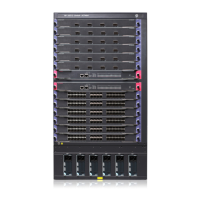254
Ste
Command
Remarks
2. Configure a static route
for a VPN instance.
• Approach 1:
ip route-static dest-address { mask |
mask-length } { gateway-address |
interface-type interface-number
[ gateway-address ] | vpn-instance
d-vpn-instance-name gateway-address }
[ preference preference-value ] [ tag
tag-value ] [ description description-text ]
• Approach 2:
ip route-static vpn-instance
s-vpn-instance-name&<1-5> dest-address
{ mask | mask-length } { gateway-address
[ public ] | interface-type interface-number
[ gateway-address ] | vpn-instance
d-vpn-instance-name gateway-address }
[ preference preference-value ] [ tag
tag-value ] [ description description-text ]
Use either command as
needed.
Perform this configuration on
PEs. On CEs, configure
normal static routes.
For more information about
static routing, see Layer 3—IP
Routing Configuration Guide.
Configuring RIP between PE and CE
A RIP process belongs to the public network or a single VPN instance. If you create a RIP process without
binding it to a VPN instance, the process belongs to the public network.
For more information about RIP, see Layer 3—IP Routing Configuration Guide.
To configure RIP between PE and CE:
Ste
Command
Remarks
1. Enter system view.
system-view N/A
2. Create a RIP process for a
VPN instance and enter RIP
view.
rip [ process-id ] vpn-instance
vpn-instance-name
Perform this configuration on PEs.
On CEs, create a normal RIP
process.
3. Enable RIP on the interface
attached to the specified
network.
network network-address
By default, RIP is disabled on an
interface.
Configuring OSPF between PE and CE
An OSPF process that is bound to a VPN instance does not use the public network router ID configured
in system view. Therefore, you must specify the router ID when starting a process or to configure the IP
address for at least one interface of the VPN instance.
An OSPF process belongs to the public network or a single VPN instance. If you create an OSPF process
without binding it to a VPN instance, the process belongs to the public network.
To configure PE-CE route exchange through OSPF:
Ste
Command
Remarks
1. Enter system view.
system-view N/A

